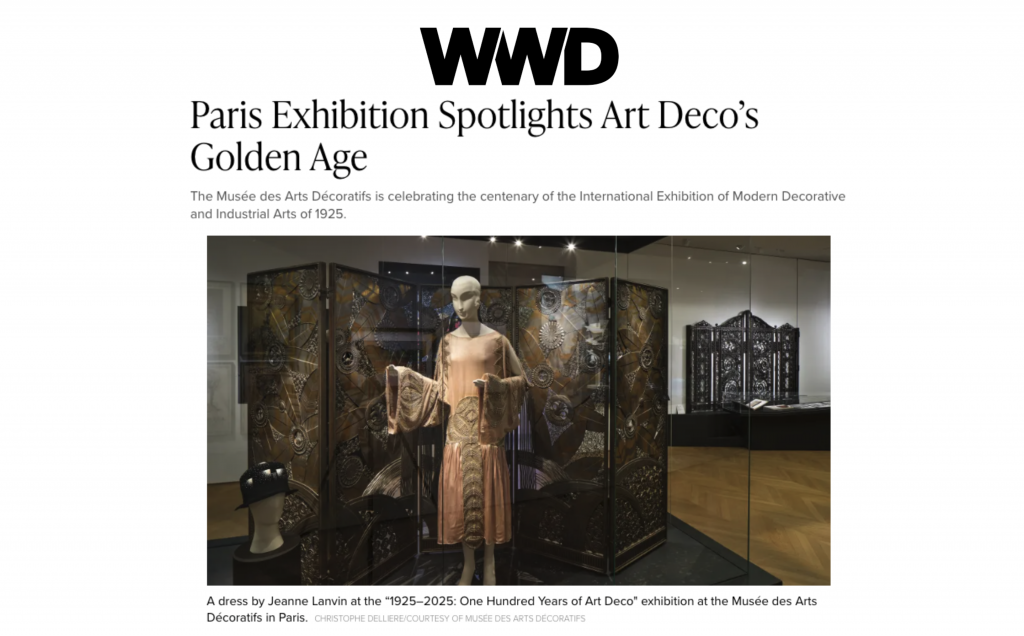WWD

PARIS – More than a century after its birth, Art Deco is once again having a moment.
The Musée des Arts Décoratifs in Paris is celebrating the seminal design movement of the Roaring 1920s with a blockbuster exhibition that includes some 1,200 items ranging from lacquer screens to diamond brooches – and even a flying train.
« We thought big. After all, Art Deco truly lies at the heart of our institution, » Anne Monier Vanryb, curator in charge of the 1910-60 collections at the museum, told WWD. « In our view, we hold the world’s most exceptional museum collection of Art Deco design, and we wanted to show it all. »
Titled « 1925)2025: One Hundred Years of Art Deco », the exhibition opening on Wednesday celebrates the 100th anniversary of the International Exhibition of Modern Decorative and Industrial Arts of 1925 with a comprehensive overview spanning furniture, jewelry, interior design, graphic art and fashion.
Special sections showcase the work of three design stars of the era – Jacques-Émile Ruhlmann, Eileen Gray and Jean-Michel Frank – alongside jewels from the likes of Cartier and Boucheron, dresses by Jeanne Lanvin, Madeleine Vionnet and others, and precious objects from heritage brands including Lalique, Christofle and Puiforcat.
Many items originally featured in the 1925 Paris showcase, which cemented the French capital’s reputation as the trendsetter for modern decorative arts, though the design movement originated a decade earlier and the term Art Deco wasn’t coined until much later.
Among the highlights is the complete library room designed by Pierre Chareau for the French Embassy pavilion presented by the Société des artistes décorateurs, or Society of Decorative Artists, the leading French grouping of its time.
The room, alongside other key exhibits, had not been seen for seven years, after a small fire prompted the extended closure of the museum’s permanent Art Deco galleries.
« We’re thrilled to be able to share our masterpieces once again. It makes this exhibition especially meaningful for the museum, as many of these works are returning to view after a long absence, » Monier Vanryb said.
« The fire did not damage the collections but there was smoke, which of course meant a thorough decontamination process, both of the building and the artworks. It took a great deal of time to fall back on our feet », she added.
Movement With No Manifesto
The diversity of the exhibits partly explains why the movement eluded definition for a long time. It wasn’t until a major show at the Musée des Arts Décoratifs in 1966 that the term Art Deco became widely used.
« The aim of this exhibition is really to show just how broad and varied Art Deco is, » Monier Vanryb said. « There’s no single manifesto or unifying theory behind it. It’s more about individuals expressing the spirit of the time through their aesthetic choices. »
The functional minimalism of a closet designed by Gray for her Villa E-1027 in the French Riviera stands in stark contrast to an anthropomorphic chest of drawers by André Groult, made of rare materials including shagreen, mahogany and ivory, she noted.
A section featuring items that belonged to fashion designer and art collector Jacques Doucet is similarly eclectic. Yves Saint Laurent, Andy Warhol and decorator Jacques Granges – who curated a room in the exhibit – attented an auction of Doucet’s collection in 1972, kickstarting an Art Deco revival that sent prices spiraling.
Those market fluctuations have not impacted the museum, which acquired many important pieces when they were originally made, and later received donations from artists of their heirs. « This history of early and continued support not only helped shape the collection, but also reinforces our legitimacy in this field, » Monier Vanryb said.
In the museum’s soaring central nave, a section dedicated to the Orient Express juxtaposes an original 1927 cabin with three full-scale models of the updated version of the luxury train, conceived by French architect and interior designer Maxime d’Angeac, ahead of its planned relaunch in spring 2027.
Visitors enter under a suspended replica of the so-called « King of Trains » and « Train of Kings », immortalized in Agatha Christie novels and James Bond movies. Elements such as lamps, wood paneling and tableware from 1925 are displayed alongside their contemporary counterparts.
